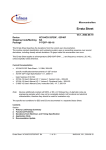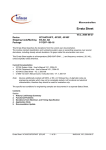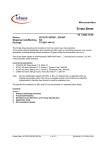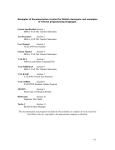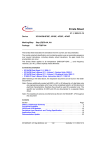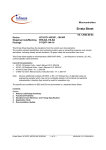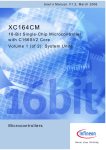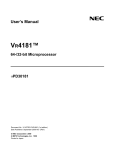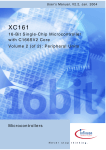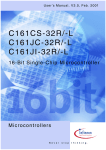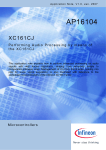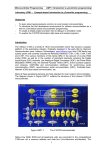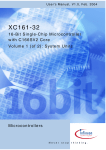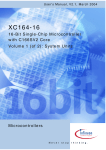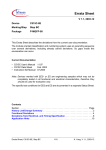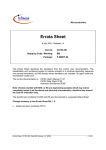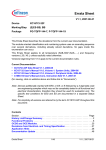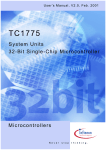Download Errata Sheet
Transcript
Microcontrollers
Errata Sheet
__________________________________________________________
V0.4, 2004-08-19
Device
Stepping Code/Marking
Package
XC161CJ-16F20F, -16F40F
ES-AD, AD
P-TQFP-144-19
This Errata Sheet describes the deviations from the current user documentation.
The module oriented classification and numbering system uses an ascending sequence over several
derivatives, including already solved deviations. So gaps inside this enumeration can occur.
This Errata Sheet applies to all temperature (SAB-/SAF-/SAK-.....) and frequency versions (.20./.40.),
unless explicitly noted otherwise.
Current Documentation
• XC161 User's Manual V2.2, Volume 1: System Units - 2004-01
• XC161 User's Manual V2.2, Volume 2: Peripheral Units - 2004-01
• XC161CJ Data Sheet - V2.2, 2003-06
• C166S V2 User's Manual (Core, Instruction Set) - V1.7, 2001-01
Note:
Devices additionally marked with EES- or ES- or E followed by a 3-digit date code are
engineering samples which may not be completely tested in all functional and electrical
characteristics, therefore they should be used for evaluation only.
The specific test conditions for EES and ES are documented in a separate Status Sheet.
Contents
Section
1. History List/Change Summary
2. Functional Problems
3. Deviations from Electrical- and Timing Specification
4. Application Hints
5. Documentation Update
Errata Sheet XC161CJ-16F20F/40F (ES-)AD
- 1 of 31 –
Mh/Es/UK, V0.4, 2004-08-19
1. History List/Change Summary
from Errata Sheet Rev. 0.3 for XC161CJ-16F devices with marking ES-AD, AD to this Errata Sheet
Rev. 0.4 for XC161CJ-16F devices with marking ES-AD, AD:
Documentation Reference updated:
- XC161 User's Manual V2.2, Volume 1/2: System/Peripheral Units - 2004-01 (printed version)
Description of the following problems added:
-
Frequency Limits for Flash Read Accesses (FCPUR_X.162832): see section “Deviations from
DC/AC Specification”
Modification of register PLLCON while CPSYS = 1 (SCU_X.008.1)
Software or Watchdog Timer Reset while Oscillator is not locked (SCU_X.009.1)
ASC Autobaud Detection in 8-bit Modes with Parity (ASC_X.001)
The following Application Hint has been added:
-
Timing of Bit IRQD (IIC_X.H2)
The following text has been added in section ‘Documentation Update’:
-
RSTLEN
duration of internal reset sequence: tRST = (2
Errata Sheet XC161CJ-16F20F/40F (ES-)AD
RSTLEN+1
) /tWDT (instead of (2
- 2 of 31 –
) /tWDT
Mh/Es/UK, V0.4, 2004-08-19
1.1 Summary of Fixed Problems
Problem Name
Short Description
Fixed in
Step
PORTS_X.001
PORTS_X.003
PORTS_X.004
PORTS_X.005
PORTS_X.006
IIC_X.001
CC12_X.001
CC12_X.002
(FLASH_X.001)
Power Loss Operation
PORT1 still active in Multiplexed Bus Modes
P0H still active in 8-bit Non-multiplexed Bus Mode
P3.5 increased leakage current for VIH/VOH > VDDI
P6.5 and P6.6 pulled high during reset
IIC Interrupt Vectors exchanged
Bit ORSEL can not be changed --> see new documentation
Bit PDS not readable --> see new documentation
Flash Access Error Trap --> replaced by Application Hint 'PMI
Access Error in TC1 EES devices'
Programming of upper 64 Kbytes of Flash module
ADC Restart in first 4 cycles
ADC self calibration disabled
Double Interrupt Requests on Single GPT12E Event
CAN Access while Pin READY# is active
Bit Modification Instructions on Interrupt Control Registers
PLL Bypass Operation
Acknowledge of PEC Transfers --> fixed by new default value in
CPUCON2
Interrupt Request during Loop with ATOMIC/EXTend Instructions
--> fixed by new default value in CPUCON2
Dynamic change of Interrupt Level
Spike Filter on ExnIN Interrupt Inputs
Unexpected NMI# Trap after reset if NMI# is permanently tied low
Oscillator (XTAL1/XTAL2) not disabled in Power Down Mode
Watchdog Timer Reset during Bootstrap Mode
Modifications of bits ROCON/ROCOFF and ROC are not taken into
account
Wake-up from Sleep Mode by RTC Interrupt
Reset Indication Flags in Register SYSSTAT
Booting from external memories in Multiplexed Bus Mode
Power Down Mode Supply Current too high
Cerberus does not follow Event Sequences during Triggered Data
Transfers
Break on MUL/DIV followed by zero-cycle jump --> replaced by
Application Hint
Bootstrap Loader accepts only 28 Bytes
Internal Pull-ups/-downs not active during HW Reset
RSTOUT# not driven during HW Reset
Booting from External Memories in 8-bit Multiplexed Bus Mode
RSTOUT# Characteristics can not be selected via P0L.0 during
Reset
Pins associated with External Bus Controller are driven after
Software Reset in Single-Chip Mode (specific description for step
(ES-)AB after correction of problem PORTS_X.007))
Sleep and Power Down Mode Supply Current influenced by P3.5
Reset value of register FOCON after Software/Watchdog Timer
reset
Sleep and power-down mode supply current with RTC disabled
EES-AA
EES-AA
EES-AA
EES-AA
EES-AA
EES-AA
EES-AA
EES-AA
EES-AA
FLASH_X.002
ADC_X.001
ADC_X.002
GPT12_X.001
CAN_X.001
CPU_X.001
PLL_X.001
INT_X.001
INT_X.002
INT_X.003
INT_X.004
INT_X.005
SCU_X.001
SCU_X.002
SCU_X.003
SCU_X.004
SCU_X.005
EBC_X.001
IPD_X.001
OCDS_X.003
(DEBUG_X.001)
BSL_X.001
PORTS_X.007
PORTS_X.008
EBC_X.004
SCU_X.006
PORTS_X.009.1
PORTS_X.010
SCU_X.007
DC_X_IPDO.60
EES-AA
EES-AA
EES-AA
EES-AA
EES-AA
EES-AA
EES-AA
EES-AA
EES-AA
EES-AA
EES-AA
EES-AA
EES-AA
EES-AA
EES-AA
EES-AA
EES-AA
EES-AA
ES-AA
EES-AA
ES-AB
ES-AB
ES-AB
ES-AB
ES-AB
ES-AC
ES-AC
ES-AC
ES-AC
Note: problems listed above may still have to be considered when using an emulation device with marking TC1
Errata Sheet XC161CJ-16F20F/40F (ES-)AD
- 3 of 31 –
Mh/Es/UK, V0.4, 2004-08-19
1.2 Summary of Open Problems
Problem Name
Short Description
EBC_X.003
SDLM_X.001
CPU_X.002
ADC_X.003
TwinCAN access with EBC enabled
Reset TXRQ - TXCPU
Branch to wrong target after mispredicted JMPI
Coincidence of Result Read and End of next Conversion or Start of
Injected Conversion in Wait for Read Mode
ADC Overrun Error Generation when result is read during last cycle
of conversion
Wake up trigger during last clock cycle before entry into sleep mode
Double Send
CPUUPD fast set/reset
Transmit after error
Double remote request
ASC Autobaud Detection in 8-bit Modes with Parity
Modification of register PLLCON while CPSYS = 1
Software or Watchdog Timer Reset while Oscillator is not locked
BRKOUT# pulsing after Instruction Pointer Debug Event
OCDS indicates incorrect status after break_now requests if
PSW.ILVL ≥ CMCTR.LEVEL
Wrong MAC Flags are declared valid at Core - OCE interface
Maximum ambient temperature during flash programming 85°C
Frequency Limits for Flash Read Accesses
ADC_X.004
SLEEP_X.001
TwinCAN2.005
TwinCAN2.006
TwinCAN2.007
TwinCAN2.008
ASC_X.001
SCU_X.008.1
SCU_X.009.1
OCDS_X.001
OCDS_X.002
OCE_X.001
TAP_X.85
FCPUR_X.162832
Errata Sheet XC161CJ-16F20F/40F (ES-)AD
Fixed in
Step
- 4 of 31 –
Mh/Es/UK, V0.4, 2004-08-19
1.3 Summary of Application Hints
Problem Name
Short Description
CPU_X.H1
CPU_X.H2
FLASH_X.H1.1
FLASH_X.H2.1
RSTOUT_X.H1
SCU_X.H1
SCU_X.H2.1
SCU_X.H3
SCU_X.H4
RTC_X.H1.1
FOCON_X.H1
TwinCAN_X.H1
Configuration of Registers CPUCON1 and CPUCON2
Special Characteristics of I/O Areas
Access to Flash Module after Program/Erase
Access to Flash Module after Wake-Up from Sleep/Idle Mode or
Shut-Down
Read Access to internal Flash Module with modified Margin Level
Minimum active time after wake-up from sleep or idle mode
Sleep Mode during PLL Reconfiguration
Clock system after wake-up from Sleep Mode
Entering Idle Mode after Flash Program/Erase
Polling of Bit ADBSY
Using the Bootstrap Loader over a Single-Wire Connection
Break on MUL/DIV followed by zero-cycle jump
Behavior of on-chip Peripherals after Break
Maximum IIC Bus Data Rate at low fCPU
Timing of Bit IRQD
Initialization of SYSCON3 for Power Saving Modes
Power Consumption during Clock System Configuration
Writing the Transmit Buffer and reading the Receive Buffer in FIFO
Mode
RSTOUT# driven by weak driver during HW Reset
Shutdown handshake by software reset (SRST) instruction
Preservation of internal RAM contents after reset
Effect of PLLODIV on Duty Cycle of CLKOUT
Changing PLLCON in Emergency Mode
Resetting and Disabling of the Real Time Clock
Read Access to register FOCON
Minimum fCAN for TwinCAN module
ADC_X.H2
Handling of Results of Injected Conversions by the A/D Converter
FLASH_X.H3.1
FLASH_X.H4
SLEEP_X.H1
SLEEP_X.H3
IDLE_X.H1
ADC_X.H1
BSL_X.H1.1
BREAK_X.H1
BREAK_X.H2
IIC_X.H1
IIC_X.H2
POWER_X.H1
POWER_X.H2.1
SDLM_X.H1
Errata Sheet XC161CJ-16F20F/40F (ES-)AD
Remarks
- 5 of 31 –
steps ≥ AC
steps ≥ AC
steps ≥ AD
steps ≥ AB
steps ≤ AC
steps ≥ AB
step AD
see Manual
V2.2 p.21-46
see Manual
V2.2 p.16-15
Mh/Es/UK, V0.4, 2004-08-19
2. Functional Problems
EBC_X.003:
TwinCAN Access with EBC enabled
If the External Bus Controller (EBC) is enabled, a read or write access to the TwinCAN module fails
when an external bus access with TCONCSx.PHA ≠ 00b precedes the TwinCAN access.
Workaround:
Since it is hard to predict the order of external bus and TwinCAN accesses (in particular when PEC
transfers are involved), it is recommended to set bitfield PHA to '00' in all TCONCSx registers which
are used for external bus accesses.
SDLM_X.001:
Reset TXRQ - TXCPU
A reset on bit TXRQ in register BUFFCON by software should reset the register TXCPU. This is the
case, if blockmode (bit BMEN, register GLOBCON) is enabled.
Failure: In all other cases TXCPU is not reset, if TXRQ is reset by software.
Note: This problem is referred to as SDLM.11 in C161JC/JI devices.
Workaround:
Reset TXCPU by software.
CPU_X.002:
Branch to wrong target after mispredicted JMPI
After a JMPI is initially mispredicted according to the static branch prediction scheme of the C166S V2,
code execution may continue at a wrong target address in the following situations:
Situation I:
a memory write operation is processed by the DMU
followed by a MUL(U)
followed by the mispredicted JMPI
Example_1:
MOV mem, [Rwn]
MUL R13, R14
JMPI cc_NV, [R6]
Situation II:
MUL(U) or DIV(L/U/LU)
followed by not-mispredicted zero-cycle jump (e.g. JMPA, JMPR, JMPS; bit CPUCON1.ZCJ = 1)
followed by the mispredicted JMPI
-
Example_2a:
MULU R13, R14
JMPA- cc_V, _some_target
JMPI cc_NV, [R6]
; predicated not taken => correct
; taken, but predicted not taken
It could be possible that the JMPI is at the jump target of the JMPA, if it is taken:
Example_2b:
MULU R13, R14
JMPA+ cc_NZ, _jmpi_addr
..... other code ....
_jmpi_addr: JMPI cc_NV, [R6]
Errata Sheet XC161CJ-16F20F/40F (ES-)AD
; predicted taken => correct
; taken but predicted not taken
- 6 of 31 –
Mh/Es/UK, V0.4, 2004-08-19
Effect on tools:
In the Altium/Tasking compiler (v7.0 and above) the problem is not present. The result of a MUL/DIV
instruction is available through the MDL/MDH SFRs. These SFRs are not allocatable by the register
allocator. Therefore, the compiler always needs a MOV instruction to transfer MDL/H to a GPR. This
avoids the problem.
In the RT- and FP-libraries (v7.0 and above) the problem was not found. Versions lower than v7.0 do
not explicitly support the C166S V2 core.
In case optimizations are implemented in future versions which could cause this problem to occur, also
a workaround will be included.
All Keil C166 tool Versions (compiler and libraries) since V3.xx do not generate a MUL(U) or a
DIV(L/U/LU) followed by either of the jump instructions JMPR, JMPS, JMPA, JMPI. Basically the
support of the C166S V2 core requires anyway V4.21 or higher.
Workarounds (e.g. for program parts written in assembly language):
-
generally disable overrun of pipeline bubbles by clearing bit CPUCON2.OVRUN (CPUCON2.4 =
0). This will result only in a negligible performance decrease, and will prohibit corruption of the
target IP of the JMPI.
or:
- provide a NOP (or any other suitable instruction) between the MUL/DIV instructions and the
succeeding jump in the above cases. To simplify, place a NOP between any MUL/DIV and a
JMPR, JMPS, JMPA, JMPI that might follow it. Other branches (CALLs, jump-on-bit instructions)
do not need to be taken into account.
ADC_X.003
Coincidence of Result Read and End of next Conversion or Start of
Injected Conversion in Wait for Read Mode
When the A/D Converter operates in wait for read mode (bit ADWR = 1 in register ADC_CON or
ADC_CTR0, respectively), and the result of a previous standard (non-injected) conversion #n is read
from the result register (ADC_DAT) in the same clock cycle as the ADC
a) completes the next standard conversion #n+1,
or
b) starts an injected conversion after conversion #n+1 has been completed at some earlier time,
the following problem will occur:
-
the interrupt request flag ADCIR for standard conversions is not set
the result of conversion #n+1 is not transferred to the result register ADC_DAT
This leads to a lock situation where the ADC will not perform further standard conversions, since there
is no trigger (interrupt request) for the PEC or interrupt service routines to read the results.
Further injected conversions are performed correctly.
Workaround 1 (for standard conversions with or without injected conversions)
In order to avoid the problem, make sure that the method (interrupt routine or PEC transfer) that is
used to read the results of standard conversions can keep track with the conversion rate of the ADC,
i.e. make sure that no wait for result read situation occurs. In this context, the following points may be
considered:
Errata Sheet XC161CJ-16F20F/40F (ES-)AD
- 7 of 31 –
Mh/Es/UK, V0.4, 2004-08-19
-
assign the highest priority to the PEC channel or interrupt service routine, and use local
register banks and the interrupt jump table cache (fast interrupt)
check for long ATOMIC or EXTEND sequences, or phases where the interrupt system is
temporarily disabled (e.g. by an operating system)
extend the ADC conversion time (bit fields ADCTC, ADSTC)
Workaround 2.1 (for standard conversions if no injected conversions are used)
Use an interrupt service routine to read the results of standard conversions from register DAT. In the
interrupt service routine, read the result register DAT twice. In case a lock situation had occurred, the
second (dummy) read access will terminate the lock situation: the next conversion result #n+1 will be
transferred to DAT, and interrupt request flag ADCIR will be set, such that the result #n+1 will be read
correctly in the associated interrupt service routine.
In contrast to Workaround 1, this workaround has less strict timing requirements, because it allows wait
for read situations and handles the result management within the interrupt service routine. The
interrupt request flag ADCIR is analyzed to identify and store new results.
The sequence in the interrupt service routine for standard conversions is e.g.:
…
MOV [Rx+], [Ry]
; read and store conversion result #n
; [Rx] points to table for results,
; [Ry] points to DAT
NOP
; wait 3 clock cycles before reading ADCIR
NOP
NOP
JB
ADCIR, Label_Done
; if ADCIR = 1, result of next conversion
; will be read in next invocation of this
; interrupt service routine (wait for read
; protection is effective)
ATOMIC #4
MOV dummy, DAT
; second read of result #n (workaround)
NOP
; wait 3 clock cycles before reading ADCIR
NOP
ATOMIC #3
JNB ADCIR, Label_Done
; if ADCIR = 1, a conversion has just finished
BCLR ADCIR
; clear interrupt request flag
MOV [Rx+], [Ry]
; read and store conversion result #n+1
; [Rx] points to table for results,
; [Ry] points to DAT
SUB s_count, #1
Label_Done:
SUB s_count, #1
JMPR cc_NZ, Label_End
…
; if required: emulation of PEC COUNT function
; decrement counter for standard conversions
;
;
;
;
;
;
;
decrement counter for standard conversions
if s_count = 0:
include code for handling of s_count = 0
(assumes that no further conversion is
started after s_count = 0, and same
interrupt as for reading the results is
used)
Label_End:
…
RETI
This routine has only the timing requirement that the 7 instructions in the ATOMIC #4 /ATOMIC #3
sequence - from the dummy read until the result is stored in case a new conversion is finished – are
executed within tc (ADC conversion time).
Errata Sheet XC161CJ-16F20F/40F (ES-)AD
- 8 of 31 –
Mh/Es/UK, V0.4, 2004-08-19
Workaround 2.2 (for standard conversions if injected conversions are used in parallel)
Use an interrupt service routine to read the results of standard conversions from register DAT. In the
interrupt service routine, read the result register DAT twice. In case a lock situation had occurred, the
second (dummy) read access will terminate the lock situation: the next conversion result #n+1 will be
transferred to DAT, and interrupt request flag ADCIR will be set, such that the result #n+1 will be read
correctly in the associated interrupt service routine.
Interference with injected conversions is avoided by disabling them temporarily.
The sequence in the interrupt service routine for standard conversions is e.g.:
…
BCLR IEN
; disable interrupts (to shorten time where
; injected conversions are disabled)
BCLR ADCIN
; temporarily disable injected conversions to
; avoid conflict between read of DAT and start
; of injected conversion for 2nd and 3rd read
; of DAT (1st read covered by workaround)
MOV [Rx+], [Ry]
; read and store conversion result #n
; [Rx] points to table for results,
; [Ry] points to DAT
NOP
; wait 3 clock cycles before reading ADCIR
NOP
NOP
JB
ADCIR, Label_Done
; if ADCIR = 1, result of next conversion
; will be read in next invocation of this
; interrupt service routine (wait for read
; protection is effective)
MOV dummy, DAT
; second read of result #n (workaround)
NOP
; wait 3 clock cycles before reading ADCIR
NOP
NOP
JNB ADCIR, Label_Done
; if ADCIR = 1, a conversion has just finished
BCLR ADCIR
; clear interrupt request flag
MOV [Rx+], [Ry]
; read and store conversion result #n+1
; [Rx] points to table for results,
; [Ry] points to DAT
SUB s_count, #1
Label_Done:
BSET IEN
BSET ADCIN
SUB s_count, #1
JMPR cc_NZ, Label_End
…
; if required: emulation of PEC COUNT function
; decrement counter for standard conversions
;
;
;
;
;
;
;
;
;
enable interrupt system again
enable injected conversions again
decrement counter for standard conversions
if s_count = 0:
include code for handling of s_count = 0
(assumes that no further conversion is
started after s_count = 0, and same
interrupt as for reading the results is
used)
Label_End:
…
RETI
This routine has only timing requirement that the 7 instructions, from the dummy read (MOV dummy,
DAT) until the result is stored in case a new conversion is finished, are executed within tc (ADC
conversion time). Note that this instruction sequence can not be interrupted, because interrupts have
been disabled to avoid interference with injected conversions.
Errata Sheet XC161CJ-16F20F/40F (ES-)AD
- 9 of 31 –
Mh/Es/UK, V0.4, 2004-08-19
Workaround 3
In order to avoid the problem, make sure that only one conversion is started at a time.
a) For standard conversions:
Instead of continuous and auto scan conversion modes, use a sequence of fixed channel single
conversions which are started in the ADC conversion complete interrupt service routine (triggered by
ADCIR) after the result of the previous conversion has been read from register DAT.
b) For injected conversions:
Instead of starting injected conversions by events of CAPCOM channel CC31, or by a period match of
timer T13 (XC164/XC167 only), injected conversions may be started via software in the CC31 or T13
interrupt routine by setting bit ADCRQ = 1. In order to avoid that CC31 or T13 events directly trigger
injected conversions while the enable bit ADCIN = 1, the enhanced mode should be used with bit
ADCTS = 0 in register ADC_CTR0.
Since the injected conversion is started by software in an interrupt service routine, no coincidence with
an instruction that would read register DAT can occur.
ADC_X.004
ADC Overrun Error Generation when result is read during last cycle of
conversion
When the A/D Converter operates without wait for read mode (bit ADWR = 0 in register ADC_CON or
ADC_CTR0, respectively), and the result of a previous conversion #n is read from the result register
(ADC_DAT) one clock cycle before the ADC completes the next standard conversion #n+1, the
overrun error interrupt request flag ADEIR is already set to ‘1’. This means that ADEIR is set one clock
cycle too early, and the result has not been overwritten. Flag ADCIR is set to ‘1’ to indicate that a new
result has been written to ADC_DAT.
Workaround:
In the auto scan conversion modes, if an interrupt service routine is used to read the result from
register ADC_DAT, the channel number included in the 4 msbs ADC_DAT[15:12] may be compared to
the channel number of the previous conversion to identify an overrun situation.
SLEEP_X.001
Wake up trigger during last clock cycle before entry into sleep
mode
When the wake up trigger (from the RTC, or from the NMI# or external interrupt input pin) occurs in a
specific time window, the device will not wake up from sleep mode until a hardware reset is asserted
on pin RSTIN#.
In general, this problem occurs when all of the following conditions are true:
(1) the wake up trigger occurs during the last clock cycle before the device enters sleep mode
(2) the VCO is involved in the clock generation (i.e. PLLCTRL = 11b, 10b, 01b)
The same effect may occur if (due to software malfunction) the device is about to enter sleep mode,
and a watchdog timer reset occurs during the last clock cycle before the device enters sleep mode.
This problem does not occur in direct drive mode where the VCO is off (PLLCTRL = 00b)
Errata Sheet XC161CJ-16F20F/40F (ES-)AD
- 10 of 31 –
Mh/Es/UK, V0.4, 2004-08-19
Workaround 1
In order to avoid the problem (when PLLCTRL ≠ 00b), make sure that the wake up trigger only occurs
after the device has already entered sleep mode:
- check the RTC before entering sleep mode. If the wake up trigger will occur soon, either skip
entry into sleep mode, or extend the time for the next wake up. If the RTC time interval is
reprogrammed, make sure that no interrupt occurs between reprogramming and entry into
sleep mode
- synchronize external wake up events such that they do not occur during the last clock cycles
before sleep mode is entered. In case the CLKOUT signal is used for synchronization, please
note the following:
o the internal spike filter on the external interrupt input pins may have a maximum delay
of 100 ns
o if the output pins are switched off during sleep mode (SYSCON1.PDCFG = 01b), the
last internal clock cycle is no longer visible on pin CLKOUT, i.e. the output drivers are
turned off one cycle before the internal clock is turned off
Workaround 2
Before entering sleep mode, set the PLL to a configuration where it can not lock (theoretical output
frequency lower than VCO base frequency). After wake-up from sleep mode, reconfigure register
PLLCON to the desired clock mode, e.g.:
…
BCLR IEN
Label_enter_sleep:
EXTR #1
MOV PLLCON, #618Eh
IDLE
; device is running in desired clock mode on
; desired target frequency
; disable interrupts
; this configuration is expected not to allow
; the PLL to lock
; enter sleep mode
Label_reconfigure_clock:
EXTR #1
; first instruction after wake up
MOV PLLCON, #target_val ; reconfigure target clock mode and frequency
Label_wait_for_target_clk:
; if defined frequency is required: wait until
MOV Rx, PLLCON
; target clock has stabilized (PLLODIV ≠ 0Fh)
CMP Rx, #target_val
JMPR cc_NE, Label_wait_for_target_clk
BSET IEN
; enable interrupts
…
Errata Sheet XC161CJ-16F20F/40F (ES-)AD
- 11 of 31 –
Mh/Es/UK, V0.4, 2004-08-19
TwinCAN2.005:
Double Send
Under the following conditions, the problem described below will occur:
Message Object X (MOX, lower priority) is in the process of actually being
transmitted, and then the transmit request bit for Message Object Y (MOY,
higher priority) is set via the user software. Other message objects MO0 ...
MOn may be pending for transmission, where the priorities are MO0 > ..>
MOY > .. > MOK... > MOn > MOX. There is no message object MOk which
has a valid transmit request and a lower message number than MOY
(priority of MOK < priority of MOY).
Symptom
MOX is sent twice, MOY is not sent.
Detailed Description
MOx is sent, but neither the transmit request is cleared, nor bit INTPND is
set. Also no transmit interrupt is requested for MOx. Instead, TXRQ of MOY
is cleared, INTPND of MOY is set and a transmit interrupt is requested for
MOY (if enabled), although MOY has actually not been transmitted.
If NEWDAT has been set for message object MOY, then MOY is setup for
transmission by the TwinCAN additionally to the INTPND, otherwise MOK
will be transmitted. If NEWDAT has not been set for message object MOY,
then MOY will not be transmitted at all, but the INTPND is set.
As TxRQ has not been cleared for MOX, MOX will be transmitted a second
time.
The gateway mode is affected as well.
In case the STT bit is used, the error will occur in any case.
Workarounds
a)
Remote frames have to be forbidden; otherwise an "uncontrolled" TxRQ will be set.
Set Message Object Transmit Requests (TxRQs) in order from 0 to 31, rather than at random.
This could be done by implementing a software array for transmit requests TxRQs[32]. When a
TxRQ bit for a Message Object has to be set, the software should write to the corresponding
location within the software array. On a regular basis, all transmit requests then have to be reset
and set according to the settings within the software array, to enable all message objects with
TxRQs to be updated in the correct order. Between reset and set the application has to wait for
the length of two CAN frames.
In order to use the gateway mode, do not set the GDFS bit in MSGFGCR.
b)
Under the same software control as in workaround a) TxRQs can be set, as long as CPUUPD is
set and only reset in the natural order. In this case Remote Frames are allowed.
Sample for workaround a)
In a for-loop the following takes place:
for (i=0;i<32;i++)
if (TxRQ[i]) Message_Object[i].MSGCTR=0xe7ff
(Send this message [TxRq=Request to Send]
Errata Sheet XC161CJ-16F20F/40F (ES-)AD
- 12 of 31 –
Mh/Es/UK, V0.4, 2004-08-19
Simplified sample code:
interrupt (CC1_T0INT) void CC1_viTmr0(void)
{
int ubObjNr;
// Interrupt which takes place on a regular base
// Message Object Number
for (ubObjNr=0;ubObjNr<32;ubObjNr++)
// for all message objects do
{
if (CAN_HWOBJ[ubObjNr].uwMSGCTR & 0x2000) // if TxRQ is still set for MOX
{
CAN_HWOBJ[ubObjNr].uwMSGCTR=0xDFFF;
// reset TxRQ
if (!(CAN_HWOBJ[ubObjNr].uwMSGCTR & 0x2)) // In case the message has been transmitted before
//resetting the TxRQ, here the INTPND is detected
TXRQs[ubObjNr]=1;
// Set TxRQ in Softwaretable
}
}
Wait the length of two CAN frames
for (ubObjNr=0;ubObjNr<32;ubObjNr++)
// for all message objects do
{
if (TXRQs[ubObjNr])
// if TxRQ is set in Softwaretable for MOX
{
if (CAN_HWOBJ[ubObjNr].uwMSGCTR & 0x2)
// In case the message has been transmitted before
//resetting the TxRQ, here the INTPND is detected
{
TXRQs[ubObjNr]=0;
// Reset TxRQ in Softwaretable
}
else
{
CAN_HWOBJ[ubObjNr].uwMSGCTR=0xe7ff;
// Set TxRQ
TXRQs[ubObjNr]=0;
// reset TxRQ in Softwaretable
}
}
}
} // End of function CC1_viTmr0
TwinCAN2.006:
CPUUPD fast set/reset
In case TxRQ is set and CPUUPD in MSGCTR is set and reset within forty CAN cycles, the message
data might be corrupted.
Detailed Description
If a transmit request is set for a message object, and this object is currently transmitted, while at the
same time the user application set CPUUPD to change the information, then a mixture of the former
information and new information may be sent. This is only the case if CPUUPD is set and reset within
40 CAN cycles.
Workarounds
a) Between setting and resetting CPUUPD there has to be a time distance of 40 CAN cycles.
b) Use MSGVAL
The application will have the following restrictions:
a) Remote frames will not be received by the message object during the time, where the
message object is tagged invalid.
b) You may lose the transmit interrupt for the already set transmit request.
c) In case no remote frames exist in the system: reset TxRQ and set CPUUPD, change the message
object and set TxRQ and reset CPUUPD again.
Errata Sheet XC161CJ-16F20F/40F (ES-)AD
- 13 of 31 –
Mh/Es/UK, V0.4, 2004-08-19
TwinCAN2.007:
Transmit after Error
During a CAN error, transmission may stop (after EOF or an error frame), until a successful reception
or a write access to the TwinCAN module.
Detailed Description
In case of a CAN error and there is no other activity on the CAN module (e.g. frame reception / frame
transmission on the other CAN node / write access to any CAN register), the transmission of
messages may stop, even if some transmit requests are still set.
The CAN module will start transmitting immediately, after a reception or a write access to the module.
Workarounds
a)
Write periodically 0xFFFF to one of the MSGCTRx registers, as this value is having no effect on
the register.
b)
In case writing to a CAN register shall be the exception, use the last error code (LEC) interrupt.
This shall start writing to one of the MSGCTRx register 0xFFFF, in case the LEC value is unequal
to 0.
TwinCAN2.008:
Double remote request
After the transmission of the remote request, TXRQ is not cleared in the receive object, if NEWDAT is
set. As a consequence the remote request is transmitted once again.
Workaround:
Clear NEWDAT after the reception of a data frame.
ASC_X.001
ASC Autobaud Detection in 8-bit Modes with Parity
The Autobaud Detection feature of the Asynchronous/Synchronous Serial Interface (ASC) does not
work correctly for 8-bit modes with even or odd parity.
The Autobaud Detection feature works correctly for 7-bit modes with even or odd parity, and for 8-bit
modes without parity.
Workaround: None
SCU_X.008.1 Modification of register PLLCON while CPSYS = 1
After a hardware reset, if bit SYSCON1.CPSYS has been set to ‘1’ by software, certain modifications of
the clock generation mode in bit field PLLCON.PLLCTRL will result in incorrect clock control behavior.
The following PLLCTRL transitions will result in incorrect behavior, and must be avoided by the user:
(1) 1xb → 0xb (x = don't care)
(2) 00b → any value other than 00b
(3) 01b → any value other than 01b
These transitions include not only explicit modifications of PLLCON by software, but also implicit
modifications of PLLCON by a watchdog timer reset.
A watchdog timer reset will implicitly set PLLCON.PLLCTRL to
a)
01b (VCO bypass with oscillator watchdog) if pin EA# is sampled high (start from internal
flash)
Errata Sheet XC161CJ-16F20F/40F (ES-)AD
- 14 of 31 –
Mh/Es/UK, V0.4, 2004-08-19
b1) 01b (VCO bypass with oscillator watchdog) if pin EA# is sampled low, and P0H.[7:5] = 000b or
011b, and ALE = low and RD# = high
b2) 00b (VCO bypass without oscillator watchdog) if pin EA# is sampled low, and P0H.[7:5] = 000b
or 011b, and both ALE and RD# are low
b3) 11b (PLL mode) for all other combinations of P0H.[7:5] if pin EA# is sampled low
Note that register SYSCON1 is only cleared after a hardware reset, therefore bit CPSYS remains at ‘1’
after a software or watchdog timer reset once it had been set by software.
If CPSYS = 1, and any of the above mentioned PLLCTRL transitions ((1) ... (3)) are executed due to an
explicit or implicit write to PLLCON, the following effect will occur:
-
the clock system is reconfigured according to the value written to register PLLCON, but flag
PLLWRI remains set at ‘1’
no further reconfigurations or modifications of the clock system are possible, neither by writing to
PLLCON by software nor by a watchdog timer or software reset.
The locked state of PLLCON can only be resolved by a hardware reset.
Workaround 1
Leave SYSCON1.CPSYS = 0 (default after hardware reset).
Workaround 2
If CPSYS = 1, before performing modifications of PLLCTRL that result in state transitions other than
1Xb ↔ 1Xb, set CPSYS = 0.
Note that a watchdog timer overflow that causes state transitions of PLLCTRL from 1X ↔ 0X or from
00 ↔ 01, and which occurs while CPSYS = 1, still leads to a locked state of PLLCON.
Workaround 3
If CPSYS = 1, in order to avoid a locked state of PLLCON after a watchdog timer reset, select the
clocking mode in PLLCTRL such that it is either identical to the status after reset (see a) .. b3) above),
or such that only state transitions from 1Xb ↔ 1Xb will occur.
Example:
for single chip mode (EA# = high), e.g. the following sequence is recommended:
(1) clear CPSYS = 0
(2) program PLLCON with setting which selects PLLCTRL = 01b (same setting as default setting
after reset)
(3) set CPSYS = 1
If a reset occurs at this point, the internal initialization phase will write the same PLLCTRL value that is
already in effect, and therefore no problem will occur.
SCU_X.009.1 Software or Watchdog Timer Reset while Oscillator is not locked
If a software reset (instruction SRST) is executed, or a watchdog timer overflow occurs while the
oscillator has not yet locked (i.e. 2048 clock cycles that exceed the XTAL1 input hysteresis have been
counted), the clock system will remain in the state it had before entry into sleep mode.
This problem occurs after wake-up from sleep mode, if the clock at XTAL1 was switched off during
sleep mode, i.e. the RTC is not running on the clock derived from XTAL1, and SRST is executed or a
watchdog overflow occurs before the oscillator has locked (flag OSCLOCK = 1).
Errata Sheet XC161CJ-16F20F/40F (ES-)AD
- 15 of 31 –
Mh/Es/UK, V0.4, 2004-08-19
If this failure mode has been entered, write accesses to register PLLCON have no effect. Entry into
sleep mode or further internal resets (SRST or WDT reset) will not change the settings of the clock
system. Also, if an oscillator fail condition or PLL unlock event occurs in this mode, the clock system
will remain unchanged. However, a PLL/OWD interrupt (flag PLLIR) will be generated.
The failure mode can only be resolved by a hardware reset (rising edge at pin RSTIN#).
Workaround 1
Before executing a SRST instruction, wait until the clock system is stable.
- If the PLL is used in locked mode, wait until OSCLOCK = 1, PLLLOCK = 1, and PLLWRI = 0.
- For other clock configurations, wait until OSCLOCK = 1 and PLLWRI = 0.
Make sure that the remaining watchdog time interval will cover the oscillator start-up and lock time after
wake-up from sleep mode. This is typically about 6 ms for a 4 MHz crystal, and about 1 ms for a 16
MHz crystal.
Workaround 2
Use an external clock source with permanent oscillation. In this case, only 2048 clock cycles need to
be considered for the remaining watchdog time interval
Workaround 3.1 (step ≥ AD only)
Use the clock from XTAL1 as clock source for the real time clock (RTC), and do not switch off the RTC
during sleep mode (i.e. set RTC_CON.0 (RUN) = 1, and RTC_CON.4 (REFCLK) = 1).
Items in OCDS and OCE Modules
The following issues have been found in the OCDS and OCE modules. Please see the debugger or
emulator manufacturer's documentation whether or not these issues actually cause a problem or
restriction when the respective tool is used.
OCDS_X.001:
BRKOUT# pulsing after Instruction Pointer Debug Event
When the ACTIVATE_PIN bit of any DxxEVT register is set and a debug event occurs, the BRKOUT#
pin is supposed to be asserted as long as the debug event condition is met.
However, when software debug mode is specified as event action in addition to asserting BRKOUT#,
and the jump into the monitor program takes place, BRKOUT# will toggle once for each instruction of
the monitor program that is executed.
This problem does not occur when software debug mode is not specified as event action, e.g. when
halt debug mode is used.
Workaround:
Set DxxEVT.ACTIVATE_PIN = 0 at the beginning of the monitor program, and set
DxxEVT.ACTIVATE_PIN = 1 at the end. Note that not all toggles (first/last instruction of monitor
program) can be avoided by this method.
Errata Sheet XC161CJ-16F20F/40F (ES-)AD
- 16 of 31 –
Mh/Es/UK, V0.4, 2004-08-19
OCDS_X.002:
OCDS indicates incorrect status after break_now requests if
PSW.ILVL ≥ CMCTR.LEVEL
When the OCDS processes a break_now request while the CPU priority level (in PSW.ILVL) is not
lower than the OCDS break level (in CMCTR.LEVEL), the actual break is delayed until either
PSW.ILVL or CMCTR.LEVEL is reprogrammed such that CMCTR.LEVEL > PSW.ILVL. If in the
meantime further debug events have occurred, register DBGSR will still indicate the status of the first
break_now request. If e.g. a software break is executed, the OCDS will accept this, but register
DBGSR will indicate the wrong cause of break.
Workarounds:
1. If the application uses tasks with different levels and debugging is to take place using the OCDS
break level feature (e.g. only tasks up to a maximum level are halted, higher-level tasks aren't halted,
and the OCDS level is programmed in between), there is no problem if:
- only classic hardware breakpoints (IP address) or software breakpoints are used (i.e. no trigger on
address, data, TASKID)
- no external pin assertions are used to trigger breaks
- no direct writes to DBGSR.DEBUG_STATE are used to force breaks
2. If break_now request sources are to be used, the maximum level of the application (PSW.ILVL)
should always be lower than the programmed OCDS break level (e.g. PSW.ILVL ≤ 14d,
CMCTR.LEVEL = 15d). This means that all generated break_now requests by the OCDS will always
be accepted, independent of the CPU / interrupt priority.
OCE_X.001:
Wrong MAC Flags are declared valid at Core - OCE interface
In case a MAC instruction (Co...) is directly followed by a MOV MSW, #data16 instruction, the upper
byte of data16 is output instead of the flags corresponding to the MAC instruction. The bug was found
with code:
coshr #00001h
mov MSW, #00100h
(+ other variations of data16)
Workaround:
Add a NOP between the two instructions:
coshr #00001h
nop
mov MSW, #00100h
(+ other variations of data16)
Errata Sheet XC161CJ-16F20F/40F (ES-)AD
- 17 of 31 –
Mh/Es/UK, V0.4, 2004-08-19
3. Deviations from Electrical and Timing Specification
Reference: XC161CJ Data Sheet - V2.2, 2003-06 (see also Status Sheet)
The following restrictions should be considered:
Symbol
Parameter
Value
TAP_X.85
Maximum ambient temperature
during flash programming
TA < 85°C (SAK version only)
FCPUR X.162832
Frequency Limits for Flash Read Accesses
For instruction and data read accesses to the internal flash module (including programming and erase
sequences), the frequency limits listed below must be considered, otherwise instructions and operands
read from the internal flash may become incorrect.
The problem depends primarily on the internal frequency fCPU and the number of wait states selected
for the flash module (bit field WSFLASH in register IMBCTR). It is statistically more likely to occur
when the ambient temperature TA is in the upper region of the specified range, and when the internal
supply voltage VDDI is in the lower region of the specified range. When the problem occurs, this typically
results in a class B trap (program access error, indicated by flag PACER = 1 in register TFR), while the
flash status register FSR signals single or double bit errors.
For applications that exceed a specific frequency limit at a given maximum ambient temperature TA, an
additional wait state for the flash module will avoid the problem as listed in the tables below.
No problem will occur in applications that use the following settings and limits:
a) Ambient Temperature -40 °C ≤ TA ≤ 85 °C
fCPU
Number of wait states for
flash module
fCPU ≤ 16 MHz
0 WS
(WSFLASH = 00b)
1 WS
(WSFLASH = 01b)
default after reset
2 WS
(WSFLASH = 10b)
16 MHz < fCPU ≤ 32 MHz
fCPU > 32 MHz
b) Ambient Temperature TA > 85 °C
fCPU
Number of wait states for
flash module
fCPU ≤ 16 MHz
0 WS
(WSFLASH = 00b)
1 WS
(WSFLASH = 01b)
default after reset
2 WS
(WSFLASH = 10b)
16 MHz < fCPU ≤ 28 MHz
fCPU > 28 MHz
Note: fCPU(max) = 40 MHz for devices marked .40F, and fCPU(max) = 20 MHz for devices marked .20F.
Errata Sheet XC161CJ-16F20F/40F (ES-)AD
- 18 of 31 –
Mh/Es/UK, V0.4, 2004-08-19
The performance decrease due to an additional wait state depends on the individual characteristics of
the software. Due to the internal instruction prefetch queue, the average performance decrease when
using 1 wait state instead of 0 wait states is expected to be approximately 5%, and approximately 15%
when using 2 wait states instead of 1 wait state.
4. Application Hints
CPU_X.H1
Configuration of Registers CPUCON1 and CPUCON2
The default values of registers CPUCON1 and CPUCON2 have been chosen to provide optimized
performance directly after reset. It is recommended
- not to modify the performance related parts (3 LSBs) of register CPUCON1
- not to modify register CPUCON2, except for test purposes or for enabling specific workarounds
under special conditions (see e.g. problem CPU_X.002 or application hint BREAK_X.H1).
CPUCON2:
reset/recommended value = 8FBBh
CPUCON1:
reset/recommended value = 0..0 0XXX X111; only the 3 lsbs are performance related
Bit Position
Field
Name
CPUCON1.[15:7] 0
CPUCON1.[6:5] VECSC
Value Description
0
00
CPUCON1.4
WDTCTL
0
CPUCON1.3
SGTDIS
0
CPUCON1.2
CPUCON1.1
CPUCON1.0
INTSCXT
BP
ZCJ
1
1
1
CPU_X.H2
; enables several performance features
reserved
scaling factor for vector table, value depends on application,
'00' is compatible to C166 systems
configuration for scope and function of DISWDT/ENWDT
instructions, value depends on application, '0' is compatible
to C166 systems
segmentation enable/disable control, value depends on
application
enable interruptibility of switch context
enable branch prediction unit
enable zero cycle jump function
Special Characteristics of I/O Areas
As an element of performance optimization, the pipeline of the C166S V2 core may perform
speculative read accesses under specific conditions. In case the prediction for the speculative read
was wrong, the read to the actually required location is restarted. While this method is uncritical e.g. for
accesses to non-volatile memories or SRAMs, it may cause problems on devices which do not tolerate
speculative reads (e.g. FIFOs which are advanced on every read access).
No speculative reads are performed in memory areas which are marked as I/O area. This memory
area includes
- the SFR and ESFR space (e.g. with buffers for received data from serial interfaces or A/D results)
- the 4 Kbyte internal I/O area (00'E000h..00'EFFFh), including IIC and SDLM module on XC161
- the 2 Mbyte external I/O area (20'0000h..3F'FFFFh), including the TwinCAN module (default: from
20'0000h .. 20'07FFh)
It is therefore recommended to map devices which do not tolerate speculative reads into the 2 Mbyte
external I/O area (20'0000h..3F'FFFFh).
Errata Sheet XC161CJ-16F20F/40F (ES-)AD
- 19 of 31 –
Mh/Es/UK, V0.4, 2004-08-19
For further special properties of the I/O areas, see p.3-13 in the XC161 User's Manual V2.0, Volume
System Units 2003-03.
FLASH_X.H1.1
Access to Flash Module after Program/Erase
After the last instruction of a program or erase command, the BUSY bit in register FSR is set to '1'
(status = busy) after a delay of one instruction cycle. When polling the BUSY flag, one NOP or other
instruction which is not evaluating the BUSY flag must be inserted after the last instruction of a
program or erase command.
No additional delay is required when performing the first operand read or instruction fetch access from
the flash module after the BUSY bit has returned to '0' (status = not busy).
FLASH_X.H2.1
Access to Flash Module after Wake-Up from Sleep/Idle Mode or
Shut-Down
In order to reduce power consumption, the devices of the XC166 family allow to selectively disable
individual modules. The flash module may be disabled upon entry into Idle or Sleep mode (selection in
register SYSCON1), and it will be automatically re-enabled after wake-up from idle/sleep. Like other
on-chip peripheral modules, the flash module may also be shut down/turned on by software (flexible
peripheral management via register SYSCON3) while not required during specific operating periods of
an application. Since the transition from active to inactive state (and vice versa) requires several clock
cycles, some special situations have to be considered when access to the flash is required directly
after wake-up:
If during entry into sleep or idle mode where the flash module shall be disabled (bit field PFCFG = 01b
in register SYSCON1),
-
a wake-up event (PEC, interrupt, NMI#) occurs before the flash deactivation process is complete,
and the corresponding PEC transfer or interrupt/trap routine wants to access operands or
instructions in the internal flash
then the flash access is automatically delayed until the flash is ready again.
When the flash is disabled by software (shut-down) by writing bit PFMDIS = 1 in register SYSCON3,
- and it is (at some later time) enabled again by writing PFMDIS = 0
- and the instruction immediately following the instruction which sets PFMDIS = 0 is fetched or reads
operands from internal flash
then the PACER flag in register TFR is set and the BTRAP routine is entered.
Therefore, it is recommended to insert 4 NOPs before the internal flash is accessed again after
PFMDIS has been set to 0.
FLASH_X.H3.1
Read Access to internal Flash Module with modified Margin Level
1. When the internal flash module is read (e.g. for test purposes) with bit field margin = 0001b (low
level margin) in register MAR, an additional wait state must be used, i.e.
- bit field WSFLASH in register IMBCTR must be set to 10b for fcpu > 20 MHz,
- bit field WSFLASH in register IMBCTR must be 01b (default after HW reset) for fcpu < 20 MHz
2. When writing to the Margin Control Register MAR (with the Write Margin command), bit MAR.7
must be written as ‘1’.
FLASH_X.H4
Minimum active time after wake-up from sleep or idle mode
If the flash module is automatically disabled upon entry into sleep or idle mode (bit field PFCFG = 01b
in register SYSCON1), sleep or idle mode should not be re-entered before a minimum active (“awake”)
Errata Sheet XC161CJ-16F20F/40F (ES-)AD
- 20 of 31 –
Mh/Es/UK, V0.4, 2004-08-19
time has elapsed. Otherwise, the current consumption during this sleep/idle phase will be ~ 1 mA
above the specified limits of the Data Sheet. Therefore,
-
If code is executed from the internal flash after wake-up, at least 16 instructions should be
executed from the internal flash before re-entering sleep/idle mode.
-
If code is executed from external memory or PRAM, wait until the flash BUSY bit returns to ‘0’
before re-entering sleep/idle mode.
-
If PEC transfers with automatic return to sleep/idle mode shall be triggered by the wake-up event,
use e.g. the following procedure:
use an auxiliary routine in internal flash that waits until the flash is ready after wake-up from
sleep or idle mode, e.g.
- define a semaphore bit that is set to ‘1’ before the IDLE instruction is executed. All trap and
interrupt service routines invoked after wake up from idle/sleep should clear this bit to ‘0’
- disable interrupts
- execute the IDLE instruction
- if idle or sleep mode is terminated by an interrupt request, the instructions following the IDLE
instruction will be executed (the interrupt request flags remain set)
- if idle or sleep mode was terminated by an NMI#, the trap handler will be invoked
- enable interrupts to allow prioritization of requests for interrupt or PEC service
- the instructions following the IDLE instruction should test the flash BUSY bit in register FSR
when the flash is ready, and at least 12 instructions have been executed after the interrupt system has
been enabled, and if the semaphore bit is still at ‘1’ (i.e. no interrupts/traps have occurred), disable
interrupts and return to the IDLE instruction.
SLEEP_X.H1
Sleep Mode during PLL Reconfiguration
The PLL may be reconfigured by software by modifying the settings in register PLLCON. When
PLLCON is written to, and the PLL was locked at that time, flag PLLLOCK in register SYSSTAT is
cleared to '0' to indicate that a reconfiguration of the clock system is in progress. In addition, in order
not to exceed the internal frequency limits, the clock divider K is set to 16, such that fPLL = fVCO/16. This
is indicated in bit field PLLODIV in register PLLCON, which returns the value Fh when read during this
reconfiguration phase. When the reconfiguration is complete, PLLLOCK = 1 and PLLODIV returns the
value which was written to PLLCON.
When the PLL is about to be reconfigured (i.e. an instruction which writes to PLLCON has been
executed, and no bypass mode has been selected), and sleep mode is entered (instruction IDLE is
executed) before the PLL has locked on the new frequency, then, after wake-up from sleep mode, the
device will stay in clock system emergency mode (flagged by SYSSTAT.PLLEM=1) with fPLL = fVCO/16
(even after the oscillator has locked again).
Therefore, it is recommended not to enter sleep mode before the PLL has locked (i.e. wait until bit
OSCLOCK = 1, PLLLOCK = 1 and bit field PLLODIV < 0Fh)
SLEEP_X.H3
Clock system after wake-up from Sleep Mode
There are different wake-up behaviors, depending on the PLL control setting used in register PLLCON
during entry into sleep mode, and depending on whether the RTC is running on the main oscillator.
Note that in either case, the VCO is turned off during sleep mode, and does not contribute to any
additional power consumption.
•
In bypass mode with VCO off (PLLCTRL = 00b), the device will directly continue to run on the
frequency derived from the external oscillator input after wake-up from sleep if the RTC is running
on the main oscillator.
Errata Sheet XC161CJ-16F20F/40F (ES-)AD
- 21 of 31 –
Mh/Es/UK, V0.4, 2004-08-19
If the RTC was not running on the main oscillator, the system will not be clocked until the amplitude
on the external oscillator input XTAL1 exceeds the input hysteresis. This requires typ. a few ms,
depending on external crystal/oscillator circuit.
With this mode, there is no oscillator watchdog function, and the system will not be clocked until
the external oscillator input XTAL1 receives a clock that exceeds the input hysteresis.
•
In bypass mode with VCO on (PLLCTRL = 01b), the device will directly continue to run on the
frequency derived from the external oscillator input after wake-up from sleep if the RTC is running
on the main oscillator.
If the RTC was not running on the main oscillator, the device will wake-up and run using the
internal PLL base frequency from the VCO (fbase/16) until the oscillator input XTAL1 is locked, and
then switch to the frequency derived from the external oscillator input.
•
In PLL mode with input clock from XTAL1 disconnected (PLLCTRL = 10b), the device will only
wake up from sleep if the RTC was not running on the main oscillator (i.e. when the main oscillator
is off during sleep mode). In this case, the device will run using the internal PLL base frequency
from the VCO (fbase/16) until the oscillator input XTAL1 is locked, and then switch to fbase/k with the
output divider selected by PLLODIV.
If the RTC is running on the main oscillator, the device will not wake-up from sleep mode with this
PLLCTRL setting. It is therefore recommended to switch to bypass mode (PLLCTRL = 00b) before
entry into sleep mode (check PLLCON for its target value before executing the IDLE instruction to
enter sleep mode).
•
In PLL mode with input clock from XTAL1 connected to the VCO (PLLCTRL = 11b), if the RTC
was not running on the main oscillator, the device will wake-up in emergency mode and run using
the internal PLL base frequency from the VCO (fbase/16) until the oscillator input XTAL1 is locked.
Then the PLL resynchronizes to the target frequency determined by the settings in register
PLLCON.
If the RTC is running on the main oscillator, the device will wake-up and stay in emergency mode
using the internal PLL frequency from the VCO (fvco/16). It is therefore recommended to switch to
bypass mode (PLLCTRL = 00b) before entry into sleep mode (check PLLCON for its target value
before executing the IDLE instruction to enter sleep mode).
IDLE_X.H1
Entering Idle Mode after Flash Program/Erase
After a program/erase operation, idle mode should not be entered before the BUSY bit in register FSR
has returned to '0' (status = not busy).
ADC_X.H1
Polling of Bit ADBSY
After an A/D conversion is started (standard conversion by setting bit ADST = 1, injected conversion by
setting ADCRQ = 1), flag ADBSY is set 5 clock cycles later. When polling for the end of a conversion, it
is therefore recommended to check e.g. the interrupt request flags ADC_CIC_IR (for standard
conversions) or ADC_EIC_IR (for injected conversions) instead of ADBSY.
BSL_X.H1.1
Using the Bootstrap Loader over a Single-Wire Connection
Beginning with step ES-AB, the bootstrap loader has been improved such that the transmission of the
acknowledge byte is not started before the stop bit time slot of the last character received has been
Errata Sheet XC161CJ-16F20F/40F (ES-)AD
- 22 of 31 –
Mh/Es/UK, V0.4, 2004-08-19
completed. This avoids a collision of the start bit of the acknowledge byte with the stop bit of the last
received character (sync byte) when a single-wire connection is used.
BREAK_X.H1
Break on MUL/DIV followed by zero-cycle jump
When a MUL or DIV instruction is immediately followed by a falsely predicted conditional zero-cycle
jump (JMPR or JMPA on any condition other than cc_UC),
and
- either a 'break now' request is set at the time the MUL / DIV instruction is being executed (i.e. a
break request on operand address, data, task ID, BRKIN# pin etc. is generated by one of the
instructions (may be up to four) preceding MUL/DIV)
- or a 'break-before-make' request (break on IP address) is derived from the instruction immediately
following the jump (jump target or linear following address, depending whether the jump is taken or
not )
then the internal program counter will be corrupted (equal to last value before jump), which will lead to
a false update of the IP with the next instruction modifying the IP.
This problem occurs for debugging with OCDS as well as with OCE.
Note:
The Tasking and Keil compilers (including libraries) do not generate this type of critical
instruction sequence.
Workarounds (choices):
For assembler programmers, one of the following workarounds may be used
(1) disable zero-cycle operation for jumps when debugging code (set CPUCON1.ZCJ to '0'), or
(2) include a NOP after any MUL/DIV instruction followed by a conditional jump (JMPR, JMPA), or
(3) do not set any 'break-before-make'-type breakpoints on the instruction following the jump, or 'break
now'-type breakpoints shortly before or on the MUL / DIV instructions
IIC_X.H1
Maximum IIC Bus Data Rate at low fCPU
The extended IIC bus data rate of 400 Kbit/s can not be used for clock frequencies fCPU < 8 MHz.
When a lower CPU frequency is used system limitations (frequency accuracy and duty cycle of serial
clock SCL) have to be considered.
IIC_X.H2
Timing of Bit IRQD
The Data Transfer Event Interrupt Request Flag IRQD in register IIC_ST is set to ‘1’ after the
acknowledge bit of the last byte has been received or transmitted.
If bit IIC_CON.INT = 0, IRQD is automatically cleared to ‘0’ by HW with a delay of 1 module clock cycle
upon a complete read or write accesses to the buffers RTB0...3 (according to the buffer size defined
via bit field CI in register IIC_CON). Therefore, after reading/writing RTB0...3, either
-
add 5 NOPS, or
read status register IIC_ST twice
before evaluating the status of flag IRQD.
POWER_X.H1
Initialization of SYSCON3 for Power Saving Modes
For minimum power consumption during power saving modes, all modules which are not required
should be disabled in register SYSCON3, i.e. the corresponding disable bits should be set to '1',
Errata Sheet XC161CJ-16F20F/40F (ES-)AD
- 23 of 31 –
Mh/Es/UK, V0.4, 2004-08-19
including bits which are marked as 'reserved' (this provides compatibility with future devices, since all
SYSCON3 bits are disable bits).
In test chip devices (marked as TC), SYSCON3 bits 14, 9, and 4 will always be read as 0, while in the
final production version, reading these bits will return the written value. This e.g. allows to check the
shut-down status of peripherals equipped with peripheral shut-down handshake.
Beginning with the AA-step of the XC161CJ/XC164CS, bit SYSCON.14 (RTCDIS) is implemented for
control of the Real Time Clock (RTC) module. Its default value after reset is RTCDIS = 0, i.e. RTC on.
POWER_X.H2.1
Power Consumption during Clock System Configuration
In the following situations
(1) during and after a hardware reset (from falling edge on RSTIN# until oscillator lock)
(2) after wake-up from sleep mode until oscillator lock
(3) after a clock failure (PLL unlock or oscillator fail) until clock reconfiguration by software the device
is internally clocked by the VCO running on the base frequency of the currently selected VCO band
divided by 16. This results in an operating frequency range of 3.75 .. 11.25 MHz.
Systems designed for lower target frequencies should consider the increased power consumption due
to the potential frequency increase during these phases of operation.
Exception in bypass mode with VCO off: in case (2), if the RTC is not running on the main oscillator,
and case in (3) the device stops until it again receives a clock from the oscillator.
RSTOUT_X.H1
RSTOUT# driven by weak driver during HW Reset
A weak driver (see specification in Data Sheet) has been implemented on pin RSTOUT# which is
driven low while RSTIN# is asserted low. After the end of the internal reset sequence, RSTOUT#
operates in default mode (strong driver/sharp edge mode, i.e. POCON20.PDM3N[15:12] = 0000b).
The software setting POCON20.PDM3N[15:12] = xx11b is not supported and should not be selected
by software, otherwise pin RSTOUT# floats.
SDLM_X.H1 Writing the Transmit Buffer and reading the Receive Buffer in FIFO Mode
The PD+bus on the XC166 architecture, accessing the FIFO of the SDLM module, works word-wise.
Writing/reading of transmit or receive buffers runs ‘halfword’-wise. To get a closer look on the
functionality of accessing the FIFO buffers, the following two paragraphs shall help.
Writing to the transmit buffer
In case the information, which shall be transmitted, is stored word-wise, the information has to be
stored twice. In the other case the user has the information as bytes, the application software has to
shift every second byte.
Note: Odd byte is written to odd position, even byte to even position.
Every piece of information has to be stored in Register TxD0.
Errata Sheet XC161CJ-16F20F/40F (ES-)AD
- 24 of 31 –
Mh/Es/UK, V0.4, 2004-08-19
high byte low byte
Write Access 1:
0x(00)(low byte)
Write Access 2:
0x(high byte)(00)
TxData1 TxData0
TxData3 TxData2
TxData5 TxData4
TxData7 TxData6
TxData9 TxData8
0x0
TxData10
Figure 1: Scheme of writing to TxD0
Application code:
Word Write:
for (i=0; i<number_of_words; i++)
{
SDLM_TxD0 = write_wordwise[i];
SDLM_TxD0 = write_wordwise[i];
}
Byte Write:
if (TxCPU & 0x1)
{
for (i=0; i<number_of_bytes-1; i+=2)
{
SDLM_TxD0 =(write_bytewise[i+1] << 8);
SDLM_TxD0 = write_bytewise[i];
}
if (number_of_bytes & 0x1)
SDLM_TxD0= write_bytewise[number_of_bytes -1];
}
else
{
for (i=0; i<number_of_bytes-1; i+=2)
{
SDLM_TxD0 = write_bytewise[i];
SDLM_TxD0 =(write_bytewise[i+1] << 8);
}
if (number_of_bytes & 0x1)
SDLM_TxD0= write_bytewise[number_of_bytes -1];
}
Reading the receive buffer
Storing the information out of the receive buffers somewhere else, or directly using the received
information, can be done byte-wise or word-wise.
RxDATA01
RxDATA00
RxD0
Figure 2 : Readable part of the receive buffer in FIFO mode
Accessing RxD0 leads to the following readout:
Errata Sheet XC161CJ-16F20F/40F (ES-)AD
- 25 of 31 –
Mh/Es/UK, V0.4, 2004-08-19
0x0
RxDATA00
first read
RxDATA01
0x0
second read
Figure 3: Reading RxD0 in FIFO mode
Here again, the software application can handle the FIFO in two different ways:
Application code:
Read Words
number_of_words=RxCNT;
number_of_words=(number_of_words >> 1) + (number_of_words & 0x1)
for (i=0; i<number_of_words; i++)
read_wordwise[i] = SDLM_RxD00 | SDLM_RxD00;
Read Bytes
received_bytes=RxCNT
for (i=0; i<received_bytes-1; i+=2)
{
read_bytewise[i]= SDLM_RxD00;
read_bytewise[i+1]=(SDLM_RxD00 >> 8);
}
if (received_bytes && 0x1)
read_bytewise[received_bytes-1]= SDLM_RxD00;
By using these techniques a simple access of the Transmit as well as the Receive FIFO can be
guaranteed.
SCU_X.H1
Shutdown handshake by software reset (SRST) instruction
In the pre-reset phase of the software reset instruction, the SCU requests a shutdown from the active
modules equipped with shutdown handshake (see Section 8.3.4 in User’s Manual, volume System
Units). The pre-reset phase is complete as soon as all modules acknowledge the shutdown state.
As a consequence, e.g. the A/D converter will only acknowledge the request after the current
conversion is finished (fixed channel single conversion mode), or after conversion of channel 0 (auto
scan single conversion mode). If the ‘wait for DAT read’ mode is selected (bit ADWR = 1), the ADC
does not acknowledge the request if the conversion result from register DAT has not been read.
Therefore, before the SRST instruction is executed, it is recommended e.g. in the continuous (fixed or
auto scan) conversion modes to switch to fixed channel single conversion mode (ADM = 00) and
perform one last conversion in order to stop the ADC in a defined way. In the auto scan conversion
modes, this switch is performed after conversion of channel 0. If a 0-to-1 transition is forced in the start
bit ADST by software, a new conversion is immediately started. If the ‘wait for DAT read’ mode is
selected, register DAT must be read after the last conversion is finished.
The external bus controller e.g. may not acknowledge a shutdown request if bus arbitration is enabled
and the HOLD# input is asserted low.
Errata Sheet XC161CJ-16F20F/40F (ES-)AD
- 26 of 31 –
Mh/Es/UK, V0.4, 2004-08-19
SCU_X.H2.1
Preservation of internal RAM contents after reset
After a power-up hardware reset the RAM contents are undefined.
The contents of the on-chip RAM modules are preserved during a software reset or a watchdog timer
reset.
Because a hardware reset can occur asynchronously to internal operation, it may interrupt a current
write operation and so inadvertently corrupt the contents of on-chip RAM. RAM contents are preserved
if the hardware reset occurs during Power-Down mode, during Sleep mode, or during Idle mode with
no PEC transfers enabled.
After any reset, RAM locations in the following area are used by the internal start-up code and will
therefore be overwritten:
0FBA0h … 0FC1Fh
Programs that e.g. perform RAM checksum calculations after reset should exclude this memory area.
SCU_X.H3
Effect of PLLODIV on Duty Cycle of CLKOUT
When using even values (0..14) for the output divider PLLODIV in register PLLCON, the duty cycle for
signal CLKOUT may be below its nominal value of 50%. This should only be a problem for applications
that use both the rising and the falling edge of signal CLKOUT.
When using odd values (1..15) for PLLODIV, where PLLODIV = 15 (0Fh) is selected by hardware only
during clock system emergency mode or reconfiguration, the duty cycle for signal CLKOUT is on its
nominal value of 50%
PLLODIV
Duty
Cycle [%]
0
45
2
33.33
4
40
6
42.86
8
44.44
SCU_X.H4
Changing PLLCON in emergency mode
10
45.45
12
46.13
14
46.67
While the clock system is in emergency mode (e.g. after wake-up from sleep, or due to an external
clock failure), the clock output divider is set to 16, i.e. PLLODIV = 0Fh in register PLLCON. Emergency
mode is terminated if the internal oscillator lock counter has received 2048 clock ticks from XTAL1.
If PLLCON is written in emergency mode, all settings except bypass modes (PLLCTRL = 0Xb) become
effective immediately within a few clock cycles. As long as the system clock is still derived from the
VCO, and if a relatively small value k is written to PLLODIV, this results in the system running on an
internal frequency of fvco/k that may exceed the specified frequency limit for the device.
In general, it is recommended to wait until PLLODIV < 0Fh before PLLCON is written. Use a timeout
limit in case a permanent clock failure is present.
FOCON_X.H1
Read access to register FOCON
Bit FOTL and bit field FOCNT in register FOCON are marked as ‘rh’ in the User’s Manual, i.e. they can
not be modified by software. If register FOCON is read directly after it was written, the value read back
from the positions of FOTL and FOCNT represents the value that was written by the preceding
instruction, but not the actual contents of FOTL and FOCNT. In order to obtain correct values for FOTL
and FOCNT, either insert one NOP or other instruction that does not write to FOCON, or read FOCON
twice and discard the first result.
Errata Sheet XC161CJ-16F20F/40F (ES-)AD
- 27 of 31 –
Mh/Es/UK, V0.4, 2004-08-19
RTC_X.H1.1 Resetting and Disabling of the Real Time Clock
The clock source for the RTC can be selected by software via bit REFCLK (bit position RTC_CON.4)
REFCLK = 0: RTC count clock signal is fOSCaux (input XTAL3)
REFCLK = 1: RTC count clock signal is fOSCmain / 32 (input XTAL1)
Register RTC_CON is not affected by a hardware/software/watchdog reset. After power-up, it is
undefined. A reset of the RTC module is achieved by setting bit SYSCON0.15/RTCRST = 1. This way,
register RTC_CON is set to 8003h (RTC runs, prescaler by 8 enabled, bit REFCLK = 0).
The RTC clocking mode (synchronous, asynchronous) is determined by bit SYSCON0.14/RTCCM.
Note that register SYSCON0 is not affected by a software or watchdog reset. This means that when a
software or watchdog reset occurred while the RTC module was in asynchronous mode (selected by
bit SYSCON0.14/RTCCM = 1), it will return to asynchronous mode after a RTC reset triggered by
setting bit SYSCON0.15/RTCRST = 1 with a bit instruction.
For a software or watchdog reset that is followed by an initialization of the RTC module, it is
recommended to
- select synchronous RTC clocking mode, i.e. clear bit SYSCON0.14/RTCCM = 0
- reset the RTC module, i.e. set bit SYSCON0.15/RTCRST = 1.
This may be achieved with one word or bit field instruction, e.g.
EXTR #1
BFLDH SYSCON0, #0C0h, #80h
; RTCRST = 1, RTCCM = 0
wait_accpos: EXTR #1
JNB ACCPOS, wait_accpos
; wait until bit ACCPOS = 1
As a general recommendation, bit REFCLK should be set to the desired value after any start-up
(hardware, software, watchdog reset), and in particular whenever the RTC module is reset by setting
bit SYSCON0.15/RTCRST = 1.
When the RTC module is not used and shall be disabled after a (power-on) hardware reset, the
following steps are recommended:
1. reset the RTC by setting bit SYSCON0.15/RTCRST = 1
2. clear the RTC run bit by setting RTC_CON.0/RUN = 0
3. disable the RTC module by setting bit SYSCON3.14/RTCDIS = 1.
Errata Sheet XC161CJ-16F20F/40F (ES-)AD
- 28 of 31 –
Mh/Es/UK, V0.4, 2004-08-19
5. Documentation Update
•
XC161 User's Manual V2.2, Volume System Units - 2004-01:
-
p. 6-4, 6-25: duration of internal reset sequence: tRST = (2
-
p. 6-5:
-
p. 6-56:
RSTLEN
RSTLEN+1
) /tWDT (instead of (2
) /tWDT
the reset value for register SYSCON3 is 9FD0h as stated in the manual,
i.e. not all modules are enabled after reset.
WDTCON_X.D1
Write access to register WDTCON
A write access to register WDTCON in unprotected or secured mode (e.g. before execution of EINIT,
or by using a special command sequence) directly
- copies bit field WDTREL of register WDTCON to the high byte of the watchdog timer register WDT
- clears the low byte of register WDT,
- and selects the WDT clock prescaler factor according to bit field WDTIN.
This means that an effective write to WDTCON has the same effect as execution of instruction
SRVWDT.
Modifications in step AC (and following)
The following modifications have been performed on devices with stepping code/marking AC and
higher:
PORTS_X.D1
Port Output Control Registers (POCONz)
The encoding of the port driver modes in bit field PDMyN of the Port Output Control Registers
POCONz (y= 0..3, z=0L, 0H, 1L, 1H, 2..4, 6, 7, 9) has been modified for weak and medium driver
mode as listed below. The settings for strong driver mode remain unchanged.
Bit field POCONz.PDMyN
0011
0100
0101
0110
0111
Mode
Notes
weak driver
medium driver
medium driver
medium driver
reserved
1)
1)
1)
2)
Notes:
1) There is no difference in the port output characteristics (driver strength, edge shape) between the 3
selections for medium driver mode (PDMyN = 010Xb, 0110b). The electrical characteristics are
comparable to medium driver/sharp edge mode of the XC16x-16F step AB devices.
2) Currently, weak driver mode is selected for setting 0111b. However there will be approximately 30
µA (low level) to 80 µA (high level) additional current on Vddp per pin which is configured as output in
weak driver mode. To avoid this, use only setting 0011b for weak driver mode.
Errata Sheet XC161CJ-16F20F/40F (ES-)AD
- 29 of 31 –
Mh/Es/UK, V0.4, 2004-08-19
Modifications in step AD (and future devices)
The following modifications have been performed on devices with stepping code/marking AD and
higher:
ADC_X.D2
A/D Converter Characteristics, Conversion Time
In order to increase accuracy, the conversion time with post calibration (default after reset) is extended
by 4tBC as follows:
resolution
with post calibration
without post calibration
8-bit
tC8 = 44tBC + tS+ 6tSYS
tC8 = 32tBC + tS+ 6tSYS
(2.75µs @ fBC = 20MHz)
(2.15µs @ fBC = 20MHz)
tC10 = 52tBC + tS+ 6tSYS
tC10 = 40tBC + tS+ 6tSYS
(3.15µs @ fBC = 20MHz)
(2.55µs @ fBC = 20MHz)
10-bit
Note:
(1) For time critical applications, post calibration may be disabled by software (set bit CALOFF = 1 in
register CTR0) after the reset calibration is finished (indicated by bit CAL = 0 in register CON1), and no
conversion is in progress (indicated by bit ADBSY = 0 in register CON). This is possible in enhanced
mode (bit MD = 1 in register CTR0) as well as in standard mode (MD = 0).
(2) The accuracy of the ADC depends to a great extent on the stability of the reference voltage VAREF, in
particular during the reset calibration phase.
(3) The ADC is currently tested with post calibration enabled. The accuracy with post calibration
disabled is guaranteed by design.
RTC_X.D2
Real Time Clock Source Selection
The clock source for the RTC can be selected by software via bit REFCLK (bit position RTC_CON.4)
REFCLK = 0: RTC count clock signal is fOSCaux (input XTAL3)
REFCLK = 1: RTC count clock signal is fOSCmain / 32 (input XTAL1)
Register RTC_CON is not affected by a hardware/software/watchdog reset. After power-up, it is
undefined. A reset of the RTC module is achieved by setting bit SYSCON0.15/RTCRST = 1. This way,
register RTC_CON is set to 8003h (RTC runs, prescaler by 8 enabled, synchronous mode, bit
REFCLK = 0). As a general recommendation, bit REFCLK should be set to the desired value after any
start-up (hardware, software, watchdog reset), and whenever the RTC module is reset by setting bit
SYSCON0.15/RTCRST = 1.
SCU_X.D1
Oscillator gain reduction
The gain of the main oscillator (pins XTAL1/2) may be reduced via software by setting bit SYSCON.12
(OSCGRED) = 1. After reset, high gain is selected by default to guarantee safe start-up.
The gain may be reduced when the oscillations have reached their full amplitude. For standard crystals
15
or ceramic resonators, this is typically 2 (32768) cycles of fXTAL1 after bit OSCLOCK = 1 (and, if the PLL
is used, PLLLOCK = 1) in register SYSSTAT. After reset, the internal reset sequence ensures that
OSCLOCK = 1 and PLLLOCK = 1 before the first instruction of the application software is executed,
unless a problem with the oscillator circuit is detected (in this case, flag PLLIR = 1).
Errata Sheet XC161CJ-16F20F/40F (ES-)AD
- 30 of 31 –
Mh/Es/UK, V0.4, 2004-08-19
If the RTC is not running on the main oscillator during sleep mode (i.e. the main oscillator is off during
sleep mode), bit SYSCON.12 (OSCGRED) should be set to ‘0’ (high gain) before entry into sleep mode
to guarantee safe oscillator start-up after wake-up from sleep.
SCU_X.D2
Functionality of register OPSEN
When a breakpoint is hit, the on-chip peripherals selected in register OPSEN are stopped and placed
in power-down mode the same way as if disabled via register SYSCON3. Registers of peripherals
which are stopped this way can be read, but not written. A read access will not trigger any actions
within a disabled peripheral.
Application hint BREAK_X.H2 (Behavior of on-chip peripherals after Break) which was valid for step
AC and earlier steps is therefore removed for the Errata Sheet of step AD (and newer steps).
Note also the following documentation updates for some versions of the User’s Manual, volume
System Units:
Register Bit
Function
Device
SYSCON3.10
SYSCON3.8
OPSEN.13
OPSEN.12
OPSEN.10
OPSEN.8
OPSEN.5
OPSEN.0
ASC1DIS
CC6DIS
CANSEN
SDLMSEN
ASC1SEN
CC6SEN
PFLSEN
ADCSEN
all XC16x
XC164, XC167
all XC16x
XC161CJ-16F
all XC16x
XC164, XC167
all devices with program flash
all XC16x
It is recommended to leave bit OPSEN.5 (PFLSEN) at its default value ‘0’. Otherwise, the program
flash is deactivated when a breakpoint is hit (i.e. it can not be read), and it has to ramp up when
program execution is resumed (i.e. synchronization between software and peripherals is lost).
SCU_X.D3
Register PLLCON after software reset
Register PLLCON is not affected by a software reset, i.e. the current clock configuration remains
unchanged. PLLCON may be reconfigured by software, or an endless loop terminated by a watchdog
timer reset may be used to force PLLCON to its hardware reset value.
SCU_X.D4
VCO band after hardware/watchdog reset in single chip mode
From the falling edge of RSTIN# until 2048 stable oscillator clocks after the rising edge of RSTIN#,
always the highest VCO band is selected (see POWER_X.H2.1). After that, for a hardware or
watchdog timer reset in single-chip mode, PLL bypass mode with the lowest VCO band is selected
during the internal reset phase (PLLCON = 2710h).
Product and Test Engineering Group, Munich
Errata Sheet XC161CJ-16F20F/40F (ES-)AD
- 31 of 31 –
Mh/Es/UK, V0.4, 2004-08-19































